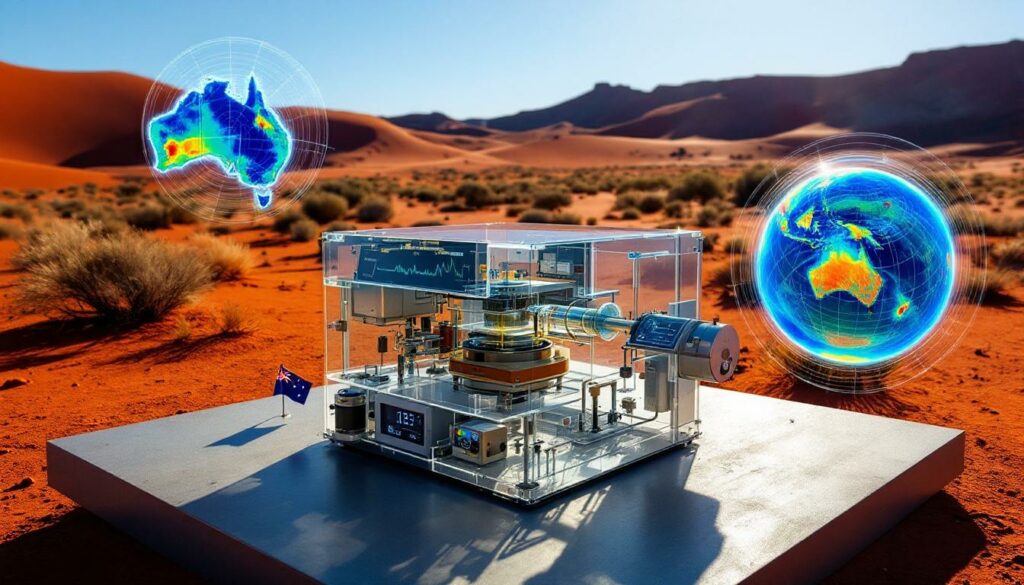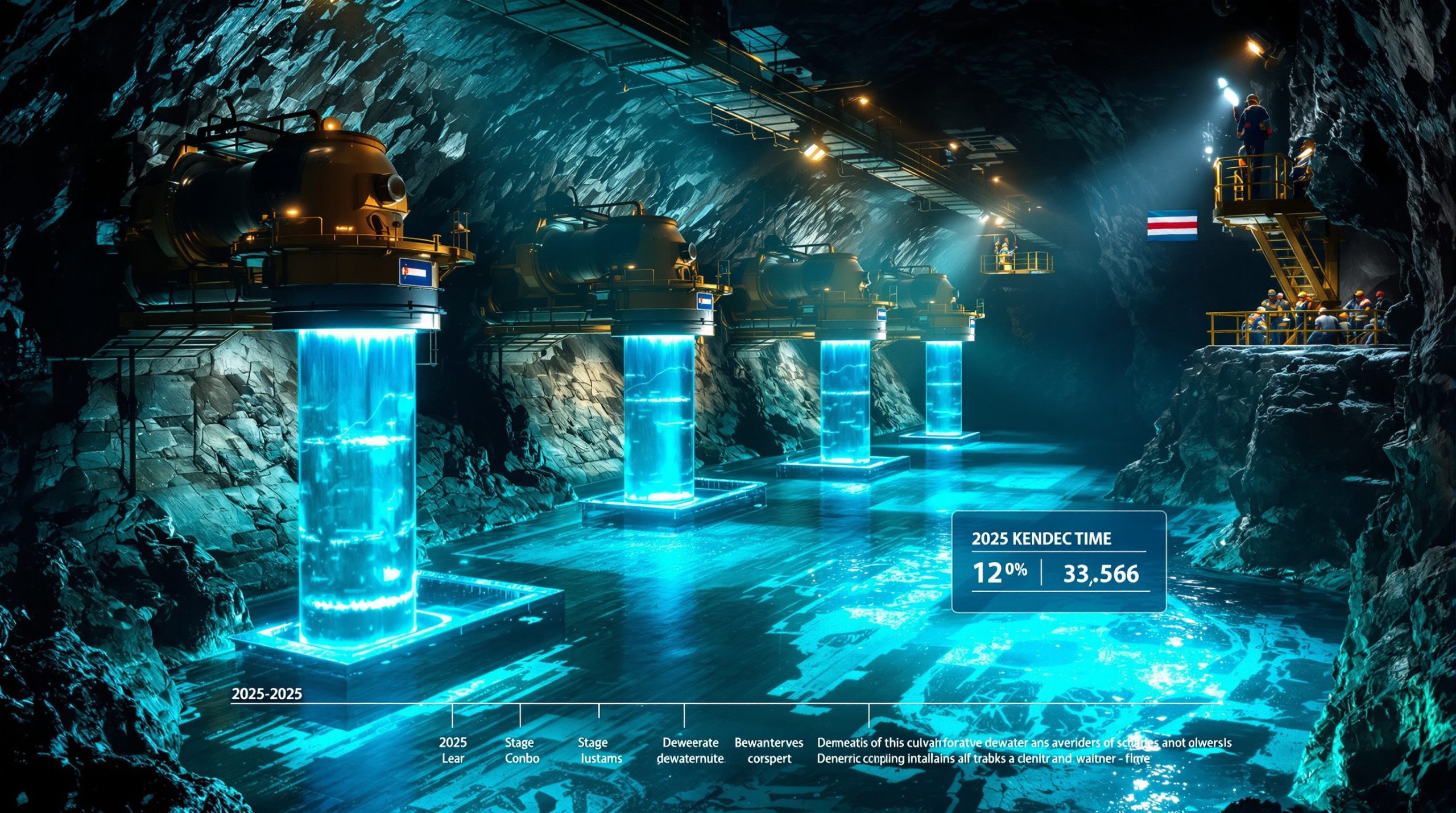What is the Australian Fundamental Gravity Network?
The Australian Fundamental Gravity Network (AFGN) serves as the backbone for continental-scale gravity mapping across Australia. This network consists of over 1,000 permanent markers installed at strategic locations throughout the country, where gravity has been precisely measured using absolute gravimeters. These markers provide essential reference points that allow thousands of relative gravity surveys to be connected into a cohesive national dataset.
According to Jack McCubbin of Geoscience Australia, "The AFGN provides absolute gravity anchor points… without it, individual relative gravity surveys would be disjoint." This highlights the critical role the network plays in Australia's geological mapping infrastructure.
Currently, only about 200 sites are confirmed as "good/okay," with 191 requiring on-site inspections and approximately 40 identified as destroyed or inaccessible. Any site not visited for over 10 years is automatically flagged with "unknown" status in the database.
The Purpose and Function of the AFGN
The AFGN enables the creation of a consistent national gravity dataset by providing fixed reference points with known gravity values. Without these anchor points, individual gravity surveys would remain disconnected, making it impossible to create comprehensive continental-scale gravity maps. The network's markers serve as calibration points for relative gravity measurements.
These brass discs or pins are installed on stable bases (typically concrete) to minimize ground vibration interference, ensuring measurement accuracy. They create the fundamental gravity datum for Australia, with values established using absolute gravimeters like the A10 that provide direct traceability to SI units.
Phil Wyn of Geoscience Australia notes that "the network is built around physical infrastructure… markers slowly vanish due to roadworks or natural processes," highlighting the ongoing challenge of maintaining this critical network.
How Gravity Varies Across Earth
While most people think of gravity as a constant 9.8 m/s², it actually varies by about 1% across Earth's surface due to several factors:
-
Earth's rotation: Creates an ellipsoidal shape with stronger gravity at the poles and weaker at the equator
-
Topography: Mountains and valleys affect local gravity
-
Subsurface density variations: Different rock types and structures create subtle gravity anomalies
-
Voids and cavities: Underground spaces can cause detectable gravity changes
These variations, while imperceptible to humans in daily life, can be precisely measured with specialized instruments called gravimeters. The subtle differences provide valuable insights into what lies beneath the surface—from mineral deposits to groundwater reservoirs.
Why Gravity Measurements Matter
Gravity data collected through the AFGN underpins a remarkable range of applications that impact Australia's economy, environment, and infrastructure planning. The economic stakes are substantial—Jack McCubbin notes that "tightening underkeel clearance models by just 10 cm saves hundreds of millions of dollars per year in exports" by allowing ships to carry heavier loads.
Australia's national gravity database contains approximately 2 million individual gravity stations collected over 70 years, representing one of the country's most valuable geoscientific datasets.
Applications in Earth Sciences and Beyond
Gravity data underpins numerous applications across various fields:
Geological Mapping and Mineral Exploration
- Delineating major crustal boundaries
- Identifying potential mineral deposits by detecting density contrasts
- Supporting modern mine planning and development
- Defining geological structures and boundaries
The ability to map density variations at depth makes gravity surveying particularly valuable for identifying iron ore deposits, kimberlite pipes (diamond sources), and other economically significant geological features. Furthermore, these methods have become increasingly important in mineral exploration insights for both traditional and critical minerals.
Water Resource Management
- Mapping groundwater systems and aquifer boundaries
- Determining basin depth and structure
- Supporting sustainable water management
- Identifying recharge zones and flow pathways
Gravity surveys can detect the subtle density differences between water-saturated and dry rock, helping hydrologists map aquifers in three dimensions.
Energy and Storage Solutions
- Identifying salt domes for hydrogen storage
- Mapping geological structures for carbon capture and storage
- Supporting geothermal resource assessment
- Locating suitable sites for pumped hydro energy storage
As Australia transitions toward renewable energy, gravity data helps identify geological formations suitable for energy storage, including subsurface reservoirs for hydrogen and carbon dioxide.
Positioning and Navigation
- Refining geoid models for accurate height determination
- Improving GPS positioning accuracy
- Supporting satellite orbit calculations
- Enhancing maritime navigation safety
GPS provides heights relative to a mathematical ellipsoid, not true "above sea level" elevations. Gravity data helps convert between these systems with centimeter-level accuracy.
Economic and Environmental Impact
The applications of gravity data translate into significant economic and environmental benefits:
- Shipping efficiency: Improved underkeel clearance models at ports like Port Hedland allow bulk carriers to maximize payloads
- Infrastructure planning: Accurate height data improves road and pipeline design
- Flood risk assessment: Better elevation models enhance flood prediction
- Climate change studies: Precise gravity measurements help track mass changes in ice sheets and sea levels
As McCubbin emphasizes, "High-quality gravity data underpins economic, social, and environmental decision-making… from mineral exploration to flood-risk assessment," making the AFGN a critical national asset.
How Gravity is Measured
Measuring gravity with precision requires specialized instruments and careful methodologies. The AFGN employs both absolute and relative measurements to create a comprehensive network.
Relative vs. Absolute Gravity Measurements
Gravity measurements fall into two main categories:
Relative Gravimeters
- Measure differences in gravity between locations
- Typically compact, shoebox-sized devices
- Use spring-based systems to detect gravity variations
- Require calibration against known reference points
- Similar to weighing scales that must be zeroed before use
These instruments are practical for field surveys but cannot establish baseline values on their own—they must be tied to absolute reference points from the Australian Fundamental Gravity Network.
Absolute Gravimeters
- Measure the actual value of gravity at a specific location
- Larger, more complex instruments (often washing machine-sized)
- Provide the foundation for the entire gravity measurement system
- Establish the reference points used by relative gravimeters
- Examples include the A10 absolute gravimeter used by Geoscience Australia
The A10 achieves an accuracy of ±0.01 mGal, as noted by Phil Wyn of Geoscience Australia. This remarkable precision allows scientists to detect even subtle subsurface features.
The A10 Absolute Gravimeter
The A10 absolute gravimeter represents current technology for establishing the AFGN:
-
Operating principle: Drops a mass in a vacuum chamber and measures its acceleration
-
Components:
- Dropping chamber (vacuum system)
- Laser interferometer system
- Superspring isolation system
- Control electronics
- Power supply
-
Measurement process:
- A laser beam is split into two paths
- One beam reflects off a stationary corner cube
- The other reflects off a corner cube that falls freely in a vacuum
- When recombined, the beams create interference patterns
- These patterns are analyzed to determine the acceleration due to gravity
- Multiple drops (typically 100+) are averaged to improve accuracy
-
Operational considerations:
- Requires continuous power to maintain vacuum
- Needs stable, solid surfaces for accurate measurements
- Sensitive to environmental conditions like wind and vibrations
- Requires two-person teams for safe handling and operation
Phil Wyn explains that a typical A10 measurement session takes 2-3 hours per site for 100+ drops. Site selection significantly impacts measurement quality—stable concrete bases yield low standard deviations (±0.3 µGal), while sites with environmental interference can have errors three times higher.
History and Evolution of the AFGN
The Australian Fundamental Gravity Network has a rich history spanning 75 years, evolving alongside advancements in measurement technology and Australia's growing need for comprehensive geoscientific data.
From Pendulums to Modern Technology
The AFGN has evolved significantly over its history:
1950s: Network Establishment
- Early measurements used pendulum gravimeters from Cambridge
- International ties established to connect with global networks
- Initial east-west traverses created due to north-south gravity gradients
- Stations like Meridan (WA) set foundations for international connections
1960s-1970s: Network Expansion
- Continued pendulum measurements
- International collaborations expanded
- First comprehensive network established
- Addition of sites in remote regions
1980s: Network Rejuvenation
- Replacement of old stations
- Integration with emerging satellite technologies
- Establishment of sites at VLBI and laser ranging facilities
- Yaragadee station installed at a laser-ranging site
1990s-2000s: Modernization
- Regular maintenance campaigns
- Increased density in strategic areas
- Preparation for new measurement technologies
- Victorian survey (1995): 14 weeks, 27,000 km driven
2000s-Present: A10 Implementation
- Transition to absolute gravity measurements
- Development of the Australian Absolute Gravity Datum 2007
- Ongoing replacement and establishment of new stations
- Horse Creek Station (WA): Rebuilt in 2015 after initial 1964 installation
As Phil Wyn notes, "Early surveys used pendulum gravimeters from Cambridge… stations like Meridan (WA) set foundations for international ties," highlighting the network's evolution from simple pendulum measurements to today's sophisticated technologies.
Current Status and Challenges
The AFGN faces several challenges that affect its usability:
- Infrastructure deterioration: Many markers have been destroyed by construction, roadworks, or natural processes
- Unknown site conditions: A significant portion of sites have unknown status due to lack of recent visits
- Coordinate accuracy: Older sites may have coordinates scaled from historical maps
- Metadata inconsistencies: Varying standards over time have created database inconsistencies
- Logistical constraints: The A10 gravimeter requires specialized transport and continuous power
The Ringwood station example demonstrates these challenges—it had to be rebuilt with a concrete slab due to the absence of reliable landmarks for positioning.
The AFGN Uplift Under RAPPY
The Australian Fundamental Gravity Network is currently undergoing a significant transformation as part of a broader national initiative.
Resourcing Australia's Prosperity Initiative
The Resourcing Australia's Prosperity Initiative (RAPPY) is a $3.4 billion, 35-year investment to secure Australia's future as a global resource supplier supporting the transition to net zero. Under this initiative, the AFGN is receiving significant upgrades to ensure it remains fit for purpose.
Jack McCubbin of Geoscience Australia emphasizes that "we're fixing the foundation and building a more consistent way to collect gravity data" through this substantial investment in national geoscientific infrastructure.
Key Improvement Areas
The AFGN uplift addresses four main areas:
1. Infrastructure and Database Integrity
- Verifying site conditions through field inspections
- Updating coordinates and metadata
- Rebuilding destroyed or inaccessible markers
- Implementing consistent data standards
- Target: Reinstall 40 high-priority marks by mid-2026
2. Stakeholder Requirements
- Improving the AFGN portal with intuitive color-coded site health indicators
- Using plain language in metadata descriptions
- Enhancing site documentation with updated images and directions
- Changed from blue triangles to color-coded symbols (green/blue = good)
3. Fieldwork Logistics
- Partnering with external contractors for efficient field operations
- Implementing standardized field procedures
- Optimizing site selection for long-term stability and accessibility
- Deshat partnership: Trained to handle A10, custom transport, 2.5 months fieldwork
4. Consistency and Standards
- Developing data and metadata standards
- Creating site selection guidelines
- Establishing safe operating procedures
- Ensuring SI traceability for all measurements
Implementation Strategy
The implementation follows a structured approach:
- Network assessment: Identifying gaps and priority sites
- Site inspections: Verifying conditions of existing markers
- New installations: Establishing markers in strategic locations
- Quality control: Validating measurements and metadata
- Data integration: Updating the national database and portal
Progress and Timeline
Significant progress has already been made:
- Over 100 site inspections completed across multiple states
- Contract established with Deshat Geodetic Surveyors for A10 operations
- Portal improvements implemented
- Standards documentation drafted
By 2032, the project aims to deliver a completely updated realization of the AFGN with consistent coverage across Australia, providing a robust foundation for the country's gravity measurements for decades to come.
Future Technologies and Directions
The field of gravity measurement continues to evolve, with emerging technologies promising to complement or potentially replace aspects of the traditional AFGN approach.
Emerging Gravity Measurement Methods
Several innovative technologies may reshape gravity measurement in the future:
Airborne Gravity
- Scalar airborne gravimetry: Measures gravity from aircraft, resolving kilometer-scale features
- Gravity gradiometry: Measures gravity gradients, detecting features down to 150m
- Both methods enable rapid coverage of large areas, including offshore regions
- AFGN markers at airports facilitate tying airborne data to the national datum
Airborne surveys offer remarkable efficiency—covering in days what would take months or years on the ground—though often with lower resolution than ground-based methods.
Miniaturized Free-Fall Meters
- Compact versions of traditional absolute gravimeters
- Potential for field use without the logistical challenges of larger instruments
- May enable on-the-fly calibration of relative surveys
- Reduced power requirements and transportation challenges
These instruments represent an evolutionary step from current technology, maintaining the same physical principles but in more practical packages for field operations.
Quantum Gravimeters
- Use quantum techniques like cold atom interferometry
- Match or exceed A10 accuracy
- Currently similar in size to A10 but becoming smaller
- Some providers offering "gravity-as-a-service" business models
Jack McCubbin notes, "We're watching [quantum gravimeters]… excited to see data from surveys like this," indicating Geoscience Australia's interest in this promising technology. Companies like Nomad Atomics are developing commercial quantum gravimeters that could eventually revolutionize the field.
Long-term Outlook
Despite technological advances, the AFGN is expected to remain relevant for approximately 30 years until alternative technologies become commonplace and traditional relative gravity surveying is completely superseded.
The future may involve a hybrid approach—maintaining critical AFGN sites while incorporating new measurement techniques for specific applications and regions. This transition period will require careful management to maintain data consistency and quality.
How the AFGN Supports Australia's Future
The Australian Fundamental Gravity Network plays a critical role in supporting national priorities and economic development.
Strategic Importance
The AFGN underpins Australia's ability to map its subsurface resources accurately, supporting:
- Mineral exploration and development
- Groundwater management
- Geological storage assessments
- Positioning infrastructure
As Jack McCubbin emphasizes, "The AFGN is built around physical infrastructure… [it] makes regional to continental scale gravity mapping possible," providing essential data for decision-makers across multiple sectors.
Contribution to RAPPY Objectives
By providing a robust gravity datum, the AFGN directly supports RAPPY's goal of securing Australia's future as a global resource supplier for the net-zero transition by enabling:
- More accurate geological mapping
- Better targeting of critical minerals
- Improved groundwater resource assessment
- Enhanced geological storage potential identification
The AFGN's role in identifying salt domes for hydrogen storage and suitable formations for carbon capture is particularly relevant to Australia's energy transition goals. These geological structures, detected through gravity anomalies, may become crucial infrastructure for a low-carbon economy.
The ability to tie airborne gravity surveys to the AFGN at airport locations also demonstrates how the network supports efficient modern data-driven operations while maintaining consistency with historical measurements.
How to Engage with the AFGN
The Australian Fundamental Gravity Network is a national resource available to various stakeholders in industry, government, and research.
For Gravity Survey Operators
If you're planning gravity surveys or visiting AFGN markers:
- Check the AFGN portal for site conditions before fieldwork
- Report site conditions and any changes observed
- Provide updated site information when possible
- Suggest strategic locations for new installations
Survey operators can contact the Geoscience Australia gravity team at gravity@ga.gov.au for information and support regarding AFGN sites.
For Data Users
If you're using gravity data in your work:
- Access the AFGN portal for reference point information
- Provide feedback on portal usability and data presentation
- Engage with the Gravity team regarding specific requirements
- Contribute to the ongoing improvement of the network
The AFGN's value increases with active user engagement, creating a collaborative ecosystem that benefits all stakeholders in Australia's geoscience community.
Further Exploration
Readers interested in learning more about Australia's gravity
Want to Catch the Next Major ASX Mineral Discovery?
Stay ahead of the market with Discovery Alert's proprietary Discovery IQ model, which provides instant notifications when significant mineral discoveries are announced on the ASX. Visit the discoveries page to see how major mineral discoveries have generated substantial returns for early investors.




